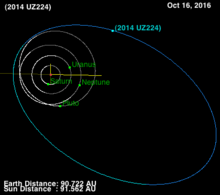2014 UZ 224
|
Asteroid 2014 UZ 224 |
|
|---|---|

|
|
| Admission by ALMA | |
| Properties of the orbit ( animation ) | |
| Orbit type | SDO or DO |
| Major semi-axis | 108.182 AU |
| eccentricity | 0.665 |
| Perihelion - aphelion | 36.263 AU - 180.102 AU |
| Inclination of the orbit plane | 26.78827 ° |
| Length of the ascending node | 130.8 ° |
| Argument of the periapsis | 30 ° |
| Time of passage of the perihelion | June 4, 2142 |
| Sidereal period | 1125 a 2.9 M. |
| Physical Properties | |
| Medium diameter | |
| Albedo | |
| Absolute brightness | 3.5 likes |
| history | |
| Explorer | David Gerdes et al. a. |
| Date of discovery | 19th August 2014 |
| Another name | "DeeDee" |
| Source: Unless otherwise stated, the data comes from JPL Small-Body Database Browser . The affiliation to an asteroid family is automatically determined from the AstDyS-2 database . Please also note the note on asteroid items. | |
2014 UZ 224 is a large trans-Neptunian object and a dwarf planet candidate . It was discovered by a team led by David Gerdes at the University of Michigan and was nicknamed DeeDee for "distant dwarf" ("distant dwarf").
discovery
The object was discovered with the DECam (Dark Energy Camera) of the 4-meter Victor M. Blanco telescope at the Cerro Tololo Inter-American Observatory as part of the Dark Energy Survey . The same small regions of the sky were photographed every week for 525 nights over 5 years in order to detect moving objects. Due to the good coverage of areas outside the ecliptic, the sky survey is well suited to discovering scattered disk objects and other trans-Neptunian objects with high inclination. For the first time in 2014, UZ 224 was observed in August 2014, then several times in 2015 and 2016.
Track properties
2014 UZ 224 orbits the sun at a distance of about 36–180 AU far beyond the orbit of Neptune in the Kuiper belt . The object needs 1125 years to complete one cycle. It is currently 91.6 AU from the Sun. This makes it the third most distant known object in the solar system after Eris and V774104 and the second most distant with known orbit data. Due to its highly eccentric orbit, it is counted among the Scattered Disk Objects . Despite observation data over two years, the orbit is so far only imprecisely known. The 2014 UZ 224 orbit is likely stable on a timescale of billions of years and shows only weak interactions with Neptune. 2014 UZ 224 may therefore belong to the detached objects (DO).
Physical Properties
With data from the ALMA radio telescope from August 19 and 20, 2016, the diameter of 2014 UZ 224 to 635 km with an albedo of 0.13 could be determined by measuring the heat radiation . A spherical shape and uniform surface properties were assumed. The observation data corresponded to a point source, so 2014 UZ 224 probably does not have a large moon .
The albedo is larger than that of stone meteorites and typical TNOs, but noticeably smaller than that of ice-rich dwarf planets such as Eris (0.96), Haumea (0.80), Pluto (0.72) or Sedna (0.32). 2014 UZ 224 therefore has a mixed composition of ice and rock. An object of this size and composition is likely to be in hydrostatic equilibrium and thus approximately spherical - one of the necessary criteria to be classified as a dwarf planet . Mike Brown runs it in its list of dwarf planet candidate as "highly likely" ( German most likely ) on. The International Astronomical Union is responsible for deciding on the status .
| year | Dimensions km | source |
|---|---|---|
| 2017 | 635.0 +65.0−72.0 | Gerdes u. a. |
| 2018 | 643.0 | Brown |
| The most precise determination is marked in bold . | ||
See also
Web links
Individual evidence
- ^ A b Calla Cofield: New Dwarf Planet Found in Our Solar System. In: Scientific American . October 12, 2016, accessed October 13, 2016 .
- ^ Kelly Beatty: New Object Vies for Kuiper Belt Record. In: Sky & Telescope . October 11, 2016. Retrieved October 13, 2016 .
- ↑ a b Mike Brown : How many dwarf planets are there in the outer solar system? October 13, 2016, accessed January 27, 2019 .
- ↑ D. Gerdes et al. a .: Discovery and physical characterization of a large Scattered Disk Object at 92 AU (March 2017, PDF).


